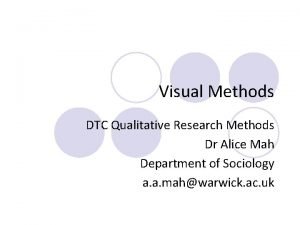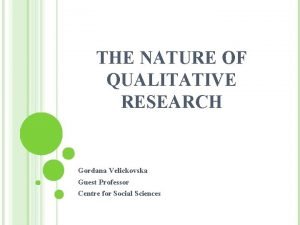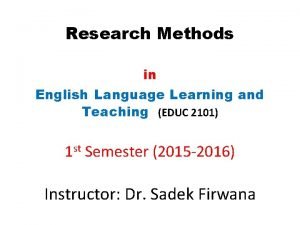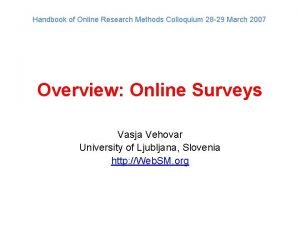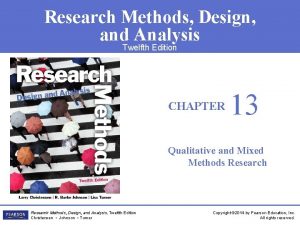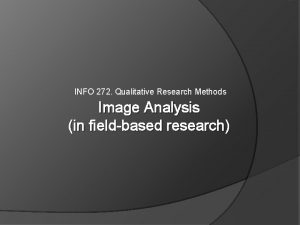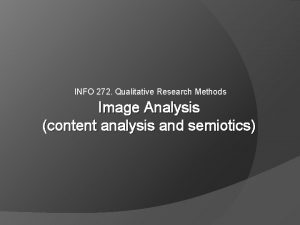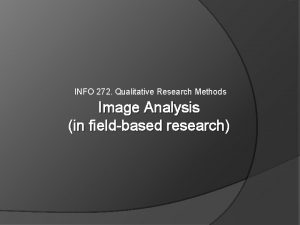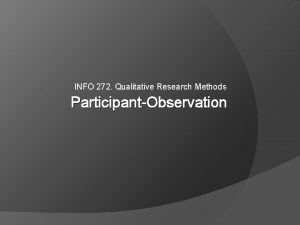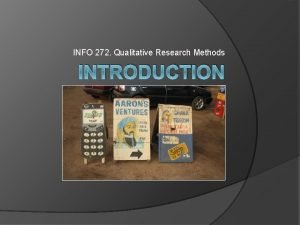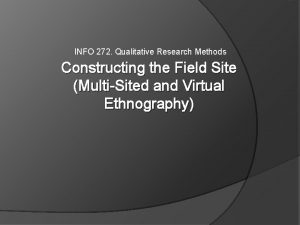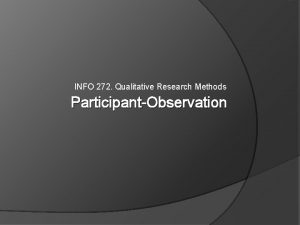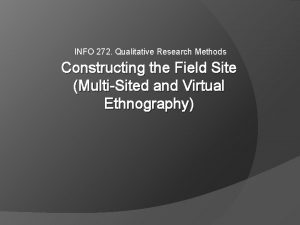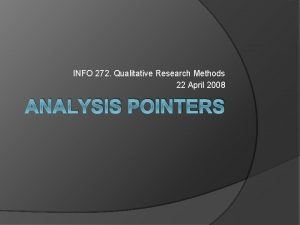INFO 272 Qualitative Research Methods Image Analysis Outline






















- Slides: 22

INFO 272. Qualitative Research Methods Image Analysis

Outline The status of images in society 2) Compositional interpretation – some vocabulary 3) Semiotic analysis 4) Content analysis of images 1)

Seeing is Believing?

A New Era of Digitally Doctored Images Source: http: //www. thememoryhole. org/media/eveningstandard-crowd. htm

Source: http: //www. thememoryhole. org/media/eveningstandard-crowd. htm


Photoshopped Bodies See 1. http: //photoshopdisasters. blogspot. com/ 2. http: //www. iwanexstudio. com/ (under portfolio)

Compositional Interpretation Content – what is the image of? Religious, historical, literary themes/events 2. Color – hue, saturation, value/brightness 3. Spatial organization – perspective, point of view, eye level 4. Light source 1.

Compositional Interpretation Moving Images 1. Screen ratio 2. Screen frame – open or closed 3. Screen plane 4. Shot distance 5. Focus 6. Angle

Compositional Interpretation Moving Images 1. Revolving: Pan, Tilt 2. Tracking, Crane 3. Zoom Editing 1. Continuity cut (classic Hollywood) 2. Jump cuts (MTV)

Semiology/Semiotics Language is relational not referential 2. Sign as unit of analysis 3. Signifier, signified, referent 1. Furthermore – icon, index, symbol 4. Studying how signs come together and work to encode social meanings Denotation (a baby, base-level meaning) vs. connotation (higher-level meaning, i. e. innocence)

Semiology/Semiotics of Images UNICORN

Semiotics: Method denotational phase, list all elements in the image and any accompanying text 2. ask what does each element connote? 3. how do the elements relate to each other in the totality? 4. what cultural knowledges are required in order to read the material? (connection to wider systems of meaning) 1. [source: Bauer and Gaskell]

Semiotics: A Classic Example

Shortcomings of Semiotics Implicit presumption about readers as ‘cultural dupes’ Elaborate, perhaps overly complex terminology Lack of concern with surrounding social practices, analyst derives meaning from the image alone – but see ‘social semiotics’

Content Analysis of Images Text Units: Clearly distinguishable units: word, sentence, proposition vs. Image Units: Units within a static image are less clear. Moving images are relatively continuous.

Content Analysis of Images (Lutz and Collins 1993)


Content Analysis of Images Code categories: 1. 2. World location (codes: Asia, Africa, etc. ) Unit of article organization (region, nation-state, ethnic group, other) … 1. 2. 3. 4. 5. 6. 7. Camera gaze of person photographed Westerners in photo (codes: yes or no) Skin color Dress style (codes: “western” or local) Male nudity (codes: yes or no) Female nudity Technological type present (codes: simple handmade tools, machinery)

Content Analysis: Some Things to Consider What exactly do these frequencies mean? Does more often mean more important? How do we get at important omissions? Good coding schemes need extensive piloting, trial and error Binary nature of codes

Summary Content analysis on large quantities of text/imagery (news media) Semiotics on persuasive/rhetorical texts/imagery (advertisements) Semiotics requires substantial cultural knowledge How do we handle what is notably absent, concealed?

Further Reading Visual Methodologies, Gillian Rose – highly recommended Williamson, Decoding Advertisements Lutz and Collins, Reading National Geographic Saussure, Pierce, and/or Barthes
 Political science methodology
Political science methodology Qualitative research research design
Qualitative research research design Purposive sampling in qualitative research
Purposive sampling in qualitative research Visual methods in qualitative research
Visual methods in qualitative research Qualitative research methods
Qualitative research methods What is the sample size in qualitative research?
What is the sample size in qualitative research? Individual interview in research
Individual interview in research Hermeneutic circle
Hermeneutic circle Qualitative research methods
Qualitative research methods Troop 272
Troop 272 Drop 과거
Drop 과거 Nanocoulomb
Nanocoulomb Half of 272
Half of 272 Purdue phys 272
Purdue phys 272 Appendix example
Appendix example What are the components of chapter 3 in research
What are the components of chapter 3 in research Eight characteristics educational research
Eight characteristics educational research Does qualitative research has holistic nature
Does qualitative research has holistic nature Interpretation of data in research example
Interpretation of data in research example Domain analysis qualitative research
Domain analysis qualitative research Factor analysis
Factor analysis Research methods design and analysis
Research methods design and analysis Characteristic of qualitative research
Characteristic of qualitative research



